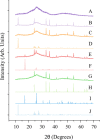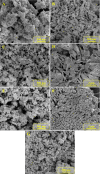Impact of Controlled Storage Conditions on the Hydrolysis and Surface Morphology of Amorphous-UO3
- PMID: 33817521
- PMCID: PMC8015116
- DOI: 10.1021/acsomega.1c00435
Impact of Controlled Storage Conditions on the Hydrolysis and Surface Morphology of Amorphous-UO3
Abstract
The hydration and morphological effects of amorphous (A)-UO3 following storage under varying temperature and relative humidity have been investigated. This study provides valuable insight into U-oxide speciation following aging, the U-oxide quantitative morphological data set, and, overall, the characterization of nuclear material provenance. A-UO3 was synthesized via the washed uranyl peroxide synthetic route and aged based on a 3-factor circumscribed central composite design of experiment. Target aging times include 2.57, 7.00, 14.0, 21.0, and 25.4 days, temperatures of 5.51, 15.0, 30.0, 45.0, and 54.5 °C, and relative humidities of 14.2, 30.0, 55.0, 80.0, and 95.8% were examined. Following aging, crystallographic changes were quantified via powder X-ray diffraction and an internal standard Rietveld refinement method was used to confirm the hydration of A-UO3 to crystalline schoepite phases. The particle morphology from scanning electron microscopy images was quantified using both the Morphological Analysis of MAterials software and machine learning. Results from the machine learning were processed via agglomerative hierarchical clustering analysis to distinguish trends in morphological attributes from the aging study. Significantly hydrated samples were found to have a much larger, plate-like morphology in comparison to the unaged controls. Predictive modeling via a response surface methodology determined that while aging time, temperature, and relative humidity all have a quantifiable effect on A-UO3 crystallographic and morphological changes, relative humidity has the most significant impact.
© 2021 The Authors. Published by American Chemical Society.
Conflict of interest statement
The authors declare no competing financial interest.
Figures







References
-
- Sweet L. E.; Henager C. J.; Hu S.; Johnson T.; Meier D.; Peper S.; Schwantes J.. Investigation of Uranium Polymorphs; 2011. 10.13140/RG.2.1.3073.0004. - DOI
-
- Hoekstra H. R.; Siegel S. The Uranium-Oxygen rSystem: U3O8-UO3. J. Inorg. Nucl. Chem. 1961, 18, 154–165. 10.1016/0022-1902(61)80383-7. - DOI
-
- Hoekstra H. R.; Siegel S. The Uranium Trioxide-Water System. J. Inorg. Nucl. Chem. 1973, 35, 761–779. 10.1016/0022-1902(73)80444-0. - DOI
-
- Greaves C.; Fender B. E. F. The Structure of α-UO3 by Neutron and Electron Diffraction. Acta Cryst. 1972, 28, 3609–3614. 10.1107/s056774087200843x. - DOI
-
- Debets P. C. The Structure of β-UO3. Acta Cryst. 1966, 21, 589–593. 10.1107/s0365110x66003505. - DOI
LinkOut - more resources
Full Text Sources
Other Literature Sources

